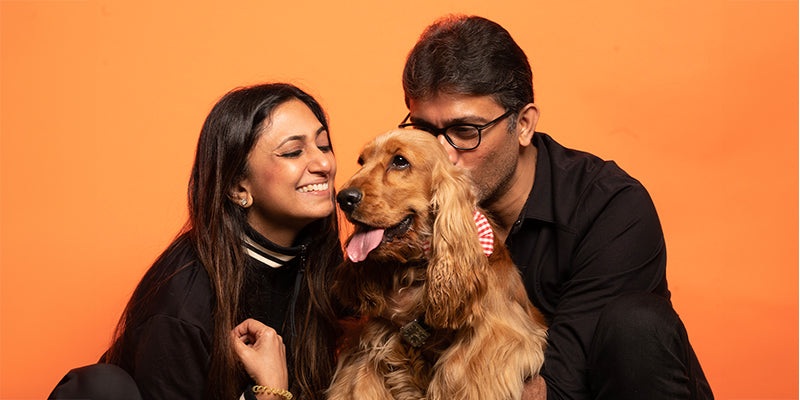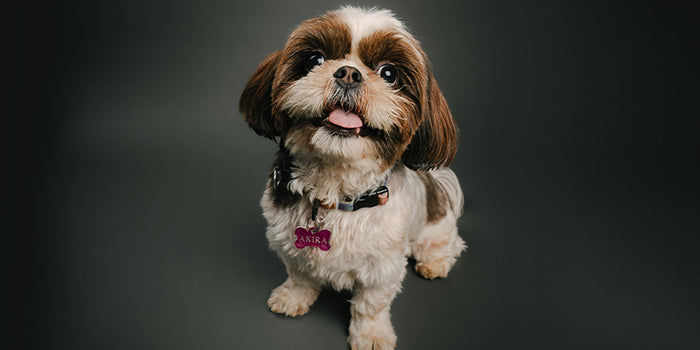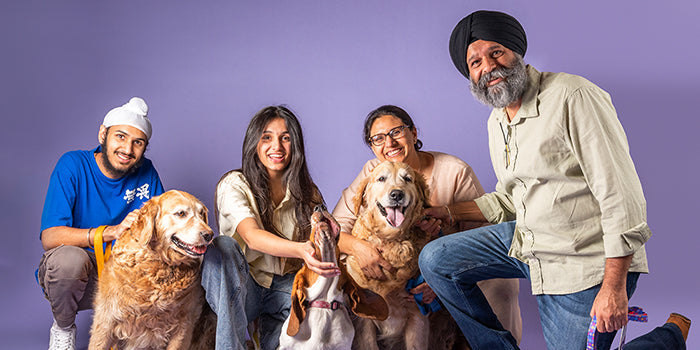

“Your memory is full”
Our phones do say that once in a while, don’t they? Well for us pet parents, this sentence can bring nothing but unadulterated JOY. Our pets don’t live as long as we do. Which is why every moment spent with them is even more precious. Pictures of our pets mean that just for a little moment, time stops and waits for us. Even if aeons pass us by, our memories associated with that one photograph live on forever.
While some doggies are natural during a pet photoshoot, some are shy and would do anything to avoid the limelight. So how does one get that one perfect shot? How can one grab our pet’s attention? What camera should one use? Are there any tricks one needs to have on their sleeves? Can one turn this hobby into a full-time career?
Instead of sniffing around on the internet, we decided to have a chat with our very own in-house HUFT Pet Photographer, Shivangi Chopra (@photo_boop), who has a special knack for understanding our furries and getting that perfect shot for all our campaigns.
So without further ado, here’s the ultimate guide to pet photography where we dig for inside tips and tricks used by our professional!

“Honestly, with my initial interest vested in fashion and lifestyle, pet photography wasn’t my forte. When I was called in for an interview at HUFT for their lead pet photographer, I was a bit under-confident as I had never explored pet photography before. However, after thorough research paired with my lifelong love for pets, I realised the beauty in the opportunity and decided to take it. Working with pets has proven to be both the most rewarding and challenging aspect of my photography journey. Despite the initial hesitation, capturing these wonderful creatures has been an incredible experience."
“Pet photography is like walking into a mine and discovering either mud or diamonds. It is very unpredictable as to how the photoshoot would be. All pets are very different and respond to commands and cues differently. Sometimes they are uncomfortable with the backdrop because of which they don’t sit. The constant flash lights going on their face also could hamper their performance, especially the new models who come in for the shoots. A lot of pets, especially cats, aren’t used to being around other people and it takes time for them to get comfortable. Some pet photoshoots also result in zero output. It’s a good idea to keep the studio as empty of people as possible.
The most hilarious part of pet photography is that pets don’t care about your business. They only care about theirs. So yes, they’ll pee and poop at any time and anywhere! An important aspect of being a pet photographer is being comfortable with, and not reacting negatively, if something gets ruined or broken. You need to just get it cleaned up and move on. This is normal and doesn’t mandate for us to be rude or mean to them as it can cause them to develop a negative association with the camera.
With pet photography, there’s SO much you can create with them! But before you enter a pet photoshoot, you need to keep chanting your mantra - BE PATIENT.”

“Keeping a close eye on your furry model is the key, as their mood can really shine through in the photographs. Over the years, I’ve picked up some tricks along the way—like recognising when a dog needs a breather, a bathroom break, or just a timeout. Every dog has their own quirks, so spending time with them during each shoot is like getting to know a new friend.
Chatting with the furry one’s parents is a game-changer too! Learning about the pet’s history, diet, and special skills add a personal touch to the whole process. For example, if Bruno is allergic to gluten, I’ll arrange for gluten-free treats. Observing common behaviours is also helpful. If a pup keeps making a beeline for the door, maybe they need to pee. If they keep slipping on paper backdrops, you’d need to keep plenty of treats handy to keep their attention elsewhere. Yummy dog treats and gentle commands work like magic to keep them focussed and sitting pretty.
The golden run is to never push or yell at your furry model. As I mentioned before, this is a surefire way to make them uncomfortable, and nobody wants a grumpy star on set! Patience, encouraging words and tons of yummy treats go a long way in capturing those perfect moments.”
“Oh, I almost got bitten that day! We were shooting with a new model and despite the pet parent’s reassurance of his friendliness, it turned out the other way. The doggo was not used to people and showed signs of aggression. I was trying my best to befriend him. Suddenly he looked up and jumped to bite. Fortunately, the pet parent had a tight grip on his leash, preventing any mishaps.
I don’t blame the dog at all. I believe that every pet has their own personality and the responsibility ultimately lies on all the pet parents to be honest about their pet’s boundaries. If your pet is not comfortable, it’s best to communicate and respect their wishes.”
“Yes! Sometime back, our adopted HUFT girls Elsie & Chelsea at our Gurgaon Head Office were in my studio with their dog trainer and behaviourist specialist Chetna Malik. The girls had shown signs of aggression in the studio before. However, this time with their trainer around, they performed wonderfully! We listened to their trainer intently and were able to capture some amazing shots. It was an insightful session as I understood their individual personalities a bit better.”
<Insert shots>
“When our model arrives, we let them off the leash to explore the studio or if outdoors, then we let them walk around the place on leash for their safety. One good trick when meeting a dog for the first time is to let them approach you first and then befriend them. Speak to the pet parents to know about any food allergies or any medical conditions that you need to be careful of while shooting.
Always sound excited and happy around them and shower them with a lot of love, scratchies and kisses. Make sure they get enough water and breaks in between shots. Treats or squeaky toys will surely grab their attention, so keep them near the camera. This will make them look directly at you.
For some active shots, you could get them a little excited about the product. So when you throw the product in the air, for example a toy, they jump to catch it! With such shots, you have to be extremely quick. Time is of the essence. On an average, a dog will only have an hour's energy before they tire out completely.”
“Now this has happened to me quite a bit, and here’s my go-to fix. Tempt them with a treat or a fun toy, drawing their focus on it, rather than the flash. You can also keep talking to them in an exciting voice. On the side, keep clicking that trigger button repeatedly to help them ease into the rhythm. It might take a bit of time, so patience is key.
In short, keep the distractions flowing as flash does its thing. It’s all about showing our doggos that those flashes are nothing to worry about. Once they’re comfortable, you’re good to go!”
“There isn’t one setting in particular that will work for all situations. You have to adjust the camera settings based on the environment or the colour of the pet’s fur. For darker fur tones, you always need more light on a background. On the other hand, for lighter fur tones with the same background, one needs less light, else the dog would appear merged with the backdrop.
Outdoor shoots also depend on the lighting and set up you are in. It’s always great to have a lot of depth in field so that the subject is in focus. Especially for action shots, your shutter speed should be high to be able to get crisp, sharp images. Light plays a really important role in pet photography (or any kind of photography) and the best time to shoot outdoors is early morning or during dusk or the golden hour.”

“The best part about pet photography is that you don’t always need high-end tech or a full fledged studio to have fun. I too love to shoot Wolf & Storm (my two fur babies) at home.
First, location is important - even for at-home pet photoshoots. Find an aesthetically pleasing spot in the house. You could also create small corners or backgrounds with props and backdrops that are easily available online or on rent.
Next is on-shoot requirements. Always keep their favourite treats and toys with you to get their attention. Make sure they have a beautiful light coming on them. Harsh light is very off putting. You could also use different sounds to get their attention.
Lastly, your phone is your most friendly gadget. You could invest in a tripod for your phone and get a wireless bluetooth remote to click pictures if you are also in the frame or use a timer. You can take some wide close ups of the doggo or catto with your phone adjusting your setting to 0.5x, taking it close to the nose to get your BOOP shot!”
“Just a couple of things: Don’t pressurise your pet for a photograph or a video as they might just not be comfortable with the camera or just not in the mood. Respect their wishes and boundaries. Make sure your pet’s relaxed and happy to get the best pictures. If you’re experimenting with a new location, remember that new environments can be overwhelming. It’s always a good idea to give them ample time to adjust to their surroundings.”
“A good way to start is by reading up and understanding pets and their behaviours. It’s important that you befriend a pet before you approach them for a pet photoshoot. You can talk to your friends or in your community who have pets. Start by shooting at home, parks or gardens. If nothing is possible, befriend your streeties and try shooting them! This entire exercise will give you a lot of confidence.
At the risk of repeating myself again, but I can’t stress on it enough, patience is the key. Make sure you always have some treats/toys with you. Let the pet/streetie approach you first. Don’t walk up straight to them and start petting. They might find you and your equipment to be overwhelming and unfamiliar.”
“I use all kinds of devices ranging from my smartphone to a GoPro, DSLR and Mirrorless camera. All are amazing, giving different results. . You just should have a good knowledge of the gadget and softwares for editing and you can shoot with anything.”

“Usually, there are no preferred settings in pet photography. It all depends upon the subject and the environment. Personally, I shoot on a Manual mode and on RAW as it gives me more control during shooting and provides ample detail for post-processing.”
“Just go out there and shoot! You’ll learn way more than just sitting with books. Do some research on current pet photographers, get inspiration from them and create something of your own. I didn’t learn pet photography from anywhere. I started to use my knowledge of lights and cameras and simply started shooting.”
“There are pros and cons to both. Studio is a very controlled environment, so it is much easier to work around and experiment. The outdoors are always more challenging since you cannot control the light. It’s always a great idea to shoot during dawn or dusk for the best light, but you can always carry portable lights or reflectors to help you play with the light. Outdoors you are very restricted with pets, since it’s very distracting plus you have a limited time to shoot before their energy drains out.”
“Expressions, actions and beautiful lighting is all you need to catch your audience’s eye. A good mix of cute faces and action shots will definitely put you in the limelight.
“This is actually extremely important. A photograph is 60% of the process. Editing plays an important role to make it enhance and beautify, play with creativity, light, frame, etc. Softwares help you expand your creative horizons with the moment and specially with the new ‘generative fill’ there is so much to create.”
“Some projects are really close to my heart. Dash Dog was a cool project, so was HUFT Summer Collection ‘23 and HUFT Winter Collection ‘23. I recently also completed a secret Christmas shoot which I absolutely love.
The best thing about these projects is that I see myself growing everyday, learning something new, and expanding my doggo model family!”
“As pets today are rightfully gaining recognition as cherished family members, India’s pet care industry is growing at a rapid speed. And as a self-taught pet photographer, I’m genuinely thrilled about the evolving industry and the scope of opportunities it provides. There’s so much room for creativity and the subject is so fun. Even non-pet brands are getting more involved with pets and they definitely need a good pet photographer who has the skill set the job demands.”
Thank you for reading till the end. We hope this guide was helpful. Now even if your phone complains of a full memory, don’t stop! Go on and create memories with your furry family member.